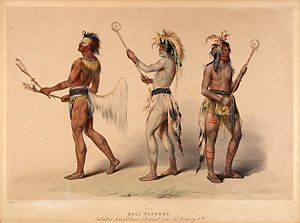Lacrosse stick
The head of a lacrosse stick is roughly triangular in shape and is strung with loose netting that allows the ball to be caught, carried (known as "cradling"), passed, or shot.Modern day lacrosse descends from and resembles games played by various Native American communities.[9] The practice still exists today to some degree, but Native Americans are not to be presented with or buried with a plastic modern lacrosse stick.[20] Throughout the 1950s and 1960s companies such as Brine and STX began experimenting with different materials to develop lacrosse sticks.[21] STX was founded in the 1960s in Baltimore by lacrosse players working for WT Burnett, a plastics company.The hollow aluminum shafts were lighter than wood and thus led to significantly faster stick movement, shots, and passes.[28] As shown in the original patent, offset is when sidewall curves in order to form a scoop-like shape.[32][33][34] In 1999, Brine filed a patent infringement against STX for their three offset (or forward cant) heads: the "X2", the "Proton", and the "Octane".[37] The wooden lacrosse stick dates back to the creation of the sport and is still made by craftsmen around the world.The only exception to this is the Western Lacrosse Association, which prohibited the use of wooden sticks by non-goaltenders some years ago.[38] A modern lacrosse stick consists of a plastic molded head attached to a metal or composite shaft.For field players in men's lacrosse, the head of the stick must be 6 to 10 inches (15 to 25 cm) wide at its widest point under NCAA rules.Mesh is typically made of nylon and comes in a variety of diamond configurations, which can affect the pocket's throwing and retention characteristics.The topstring is often made of a slightly thicker string, in order to resist the abrasive forces that come from scooping the ball up.[45] As of the 2013 season, the NCAA has passed a rule stating that shooting strings are limited to an area within a 4-inch (10 cm) arc drawn from the top of the plastic of the scoop.NCAA rules dictate that the head of a woman's stick may be from seven to nine inches wide at its widest point.The inside width of the stick must continually increase from the ball stop to the widest point of the head.[47] Up until 2018, nylon mesh was not permitted in women's sticks,[48] although traditional stringing remains a popular option.When a goalie stick is strung traditionally, they are required to have 6 or 7 runners, while also using eight to twelve stitches of cross-lacing.A goalie has no restrictions for the placement or design of shooter strings so long as the ball can move freely in the stick.








lacrosselithographGeorge CatlinNative AmericanstickballIroquoishickorysteam bendingLeatherbox lacrosse goaltendersfield lacrosseCanadian Lacrosse AssociationWorld LacrosseWestern Lacrosse AssociationCoquitlam AdanacsgrandfatheredgoaliealuminumtitaniumscandiumplasticfiberglassHistoryStrategyCollegeWomen'sIntercrosseHelmetAustraliaBermudaCanadaCzech RepublicEnglandIsraelNetherlandsScotlandUnited StatesWorld ChampionshipWomen's World CupWorld Indoor ChampionshipU19 World ChampionshipsWorld Junior Lacrosse ChampionshipEuropean ChampionshipsLacrosse at the Summer OlympicsInternationalGoaltender (box lacrosse)Goaltender (field lacrosse)Canadian Lacrosse Hall of Fame inducteesPolocrosse